THE REAL TEST OF THE 2023 SUZUKI RM-Z450—PLUS VIDEO
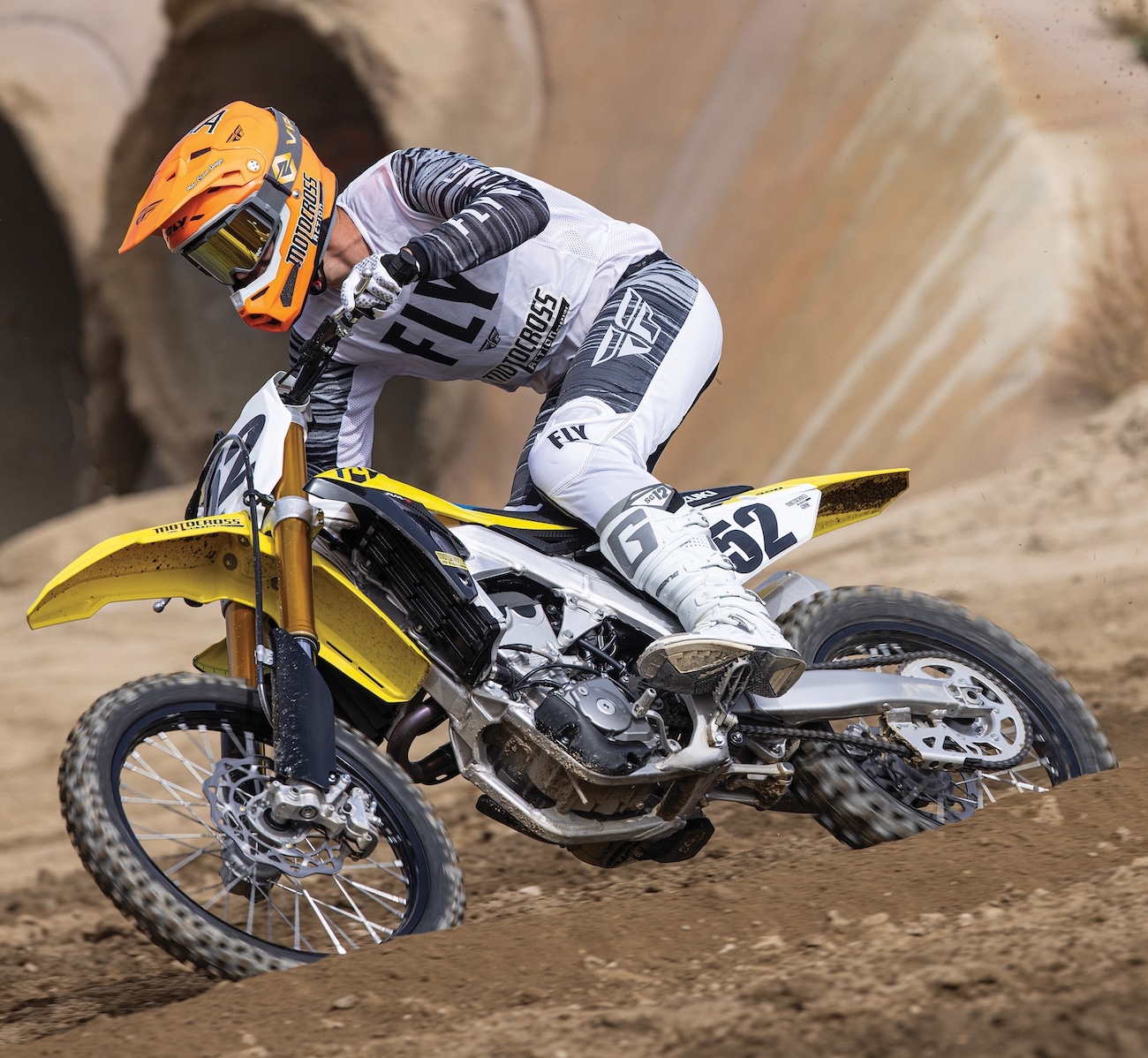 THE GEAR: Jersey: Fly Racing Kinetic Mesh, Pants: Fly Racing Kinetic Mesh, Helmet: Fly Racing Formula, Goggles: Viral Brand Signature Series, Boots: Gaerne SG12.
THE GEAR: Jersey: Fly Racing Kinetic Mesh, Pants: Fly Racing Kinetic Mesh, Helmet: Fly Racing Formula, Goggles: Viral Brand Signature Series, Boots: Gaerne SG12.
Q: FIRST AND FOREMOST, IS THE 2023 SUZUKI RM-Z450 BETTER THAN THE 2022 RM-Z450?
A: No! The 2023 RM-Z450 package was first introduced in 2018, received a minor shock spring update in 2019 (from a 56 N/mm spring to a 54 N/mm spring) and was untouched in 2020, 2021, 2022 and 2023. It’s not that it doesn’t need updates; it’s just that Suzuki doesn’t want to invest money in it.
Q: WHAT ARE THE AREAS WHERE THE 2023 SUZUKI RM-Z450 SHINES?
A: Here is a quick list of where the 2023 RM-Z450 shines.
(1) Price. The MSRP of the full spectrum of the 450cc motocross bikes for 2023 runs from $10,999 for the Husqvarna FC450 to $10,899 for the KTM 450SXF to $10,199 for the GasGas MC450F to $9899 for the YZ450F to $9599 for the KX450 and CRF450 to $8999 for the 2023 Suzuki RM-Z450. That is a $1900 spread from the most to least expensive.
(2) Cornering. For decades the Suzuki was the best-turning bike on the track, but most of its competition has closed the handling gap. They have closed it, but they haven’t surpassed it. The RM-Z450 is still the king when it comes to railing tight inside lines.
(3) Powerband. Every MXA test rider loves the RM-Z450 powerband, not because of the quantity of horsepower, but because of its excellent midrange positioning.
(4) Ergos. The bodywork, which was updated in 2018, is narrow. The bar bend is comfortable, and everything falls easily at hand.
(5) Tuneablity. The 2023 RM-Z comes with three plug-in maps: stock (grey), aggressive (white) and mellow (black), and Suzuki offers its MX-Tuner 2.0 app for Apple and Android phones. The app comes with four pre-programmed maps (aggressive, smooth, rich and lean), and you can make your own custom maps by changing the numbers in the 36 available boxes. You have to plug the MX-Tuner 2.0 connector into the RM-Z’s data cable to upload your selected or custom maps into one of the three Suzuki couplers, and you need to connect a separate 12-volt battery into the RM-Z450’s battery connector to provide power for the updates.
(6) Color. The yellow plastic is a thing of beauty in motion. It looks clean, even when it’s dirty.
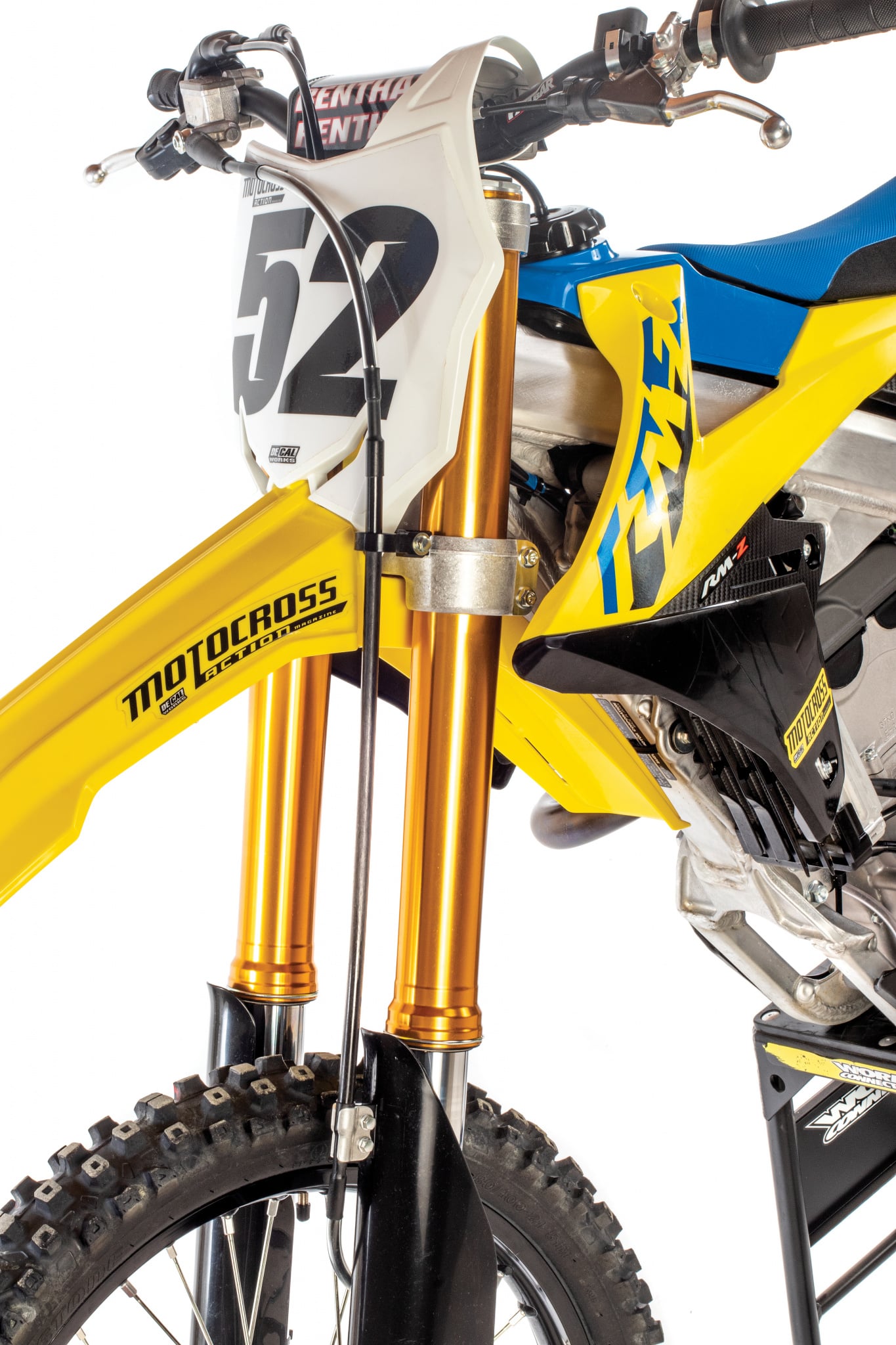 The 2023 Suzuki RM-Z450 shares the same 49mm Showa forks with the KX450 and CRF450, but strangely enough, the RM-Z250 forks work better on the RM-Z450 than the stock 450 forks.
The 2023 Suzuki RM-Z450 shares the same 49mm Showa forks with the KX450 and CRF450, but strangely enough, the RM-Z250 forks work better on the RM-Z450 than the stock 450 forks.
Q: WHAT ARE THE CATEGORIES WHERE THE 2023 SUZUKI RM-Z450 MISSES OUT?
A: MXA’s job is to evaluate each machine thoroughly enough to separate the wheat from the chaff. Here is a list of the RM-Z450’s chaff.
(1) Weight. At 241 pounds before you put gas in the tank, the RM-Z450 is the heaviest bike on the track. For comparison, it weighs a hair under 20 pounds more than the 2023 GasGas MC450F. You might convince yourself that weight doesn’t matter, but added weight is not a plus when it comes to braking, acceleration, suspension or putting the RM-Z450 up on a bike stand.
(2) Starting. Electric starting is a fact of life on every other 2023 four-stroke except for the Suzuki. That doesn’t mean that having to kick it is the end of the world; it is just that when you stall or crash in the middle of a race, it is going to take much longer to get your RM-Z450 back in action. Making matters worse is that Suzuki’s kickstart lever is very high on the cases. So high that short riders with bad knees and weak riders have trouble getting a full kick.
(3) Clutch. Have you noticed that the 2023 Kawasaki KX450 and Yamaha YZ450F have borrowed KTM’s Belleville washer-activated clutch design for their basket and pressure plate? (Yamaha went so far as to adopt KTM’s steel clutch basket with the primary gear CNC-machined into the basket.) That means that KTM, Husqvarna, GasGas, Kawasaki and Yamaha all have updated clutches. Honda did not borrow a page from the KTM playbook, but in the last few years the CRF5450 got eight plates, six springs, hydraulic actuation, 27 percent more oil capacity and dropped the horrible judder spring. If the MXA test riders were asked to rank the seven clutches, Suzuki’s clutch would come in last. If you can’t afford a $1200 Hinson or Rekluse clutch for your RM-Z450, invest in stiffer clutch springs.
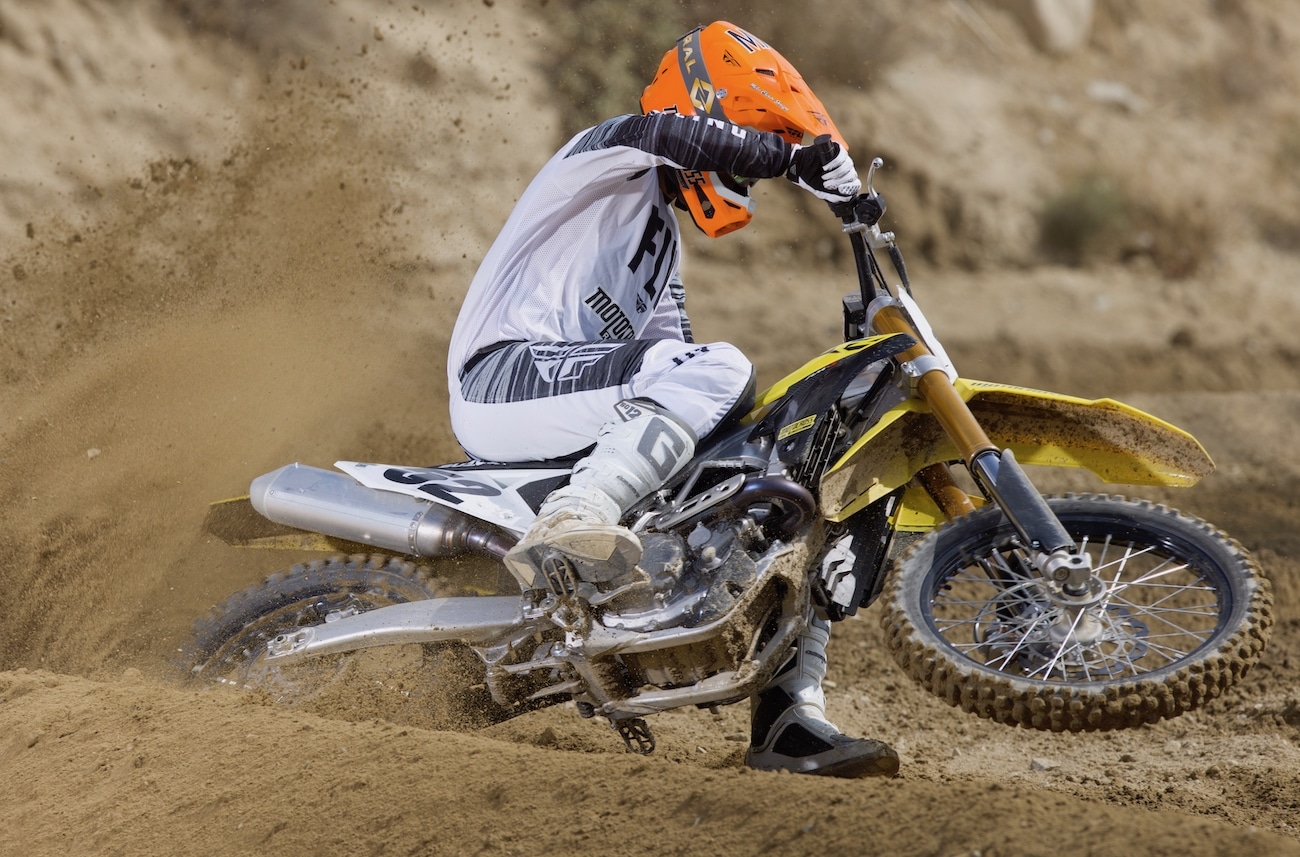
(4) Handling. In what is a cruel paradox, the best turning bikes are no longer considered the best handling. The frame geometry required to hug the inside and rail around a tight corner is a liability on fast, rough, sweeping and rugged racetracks. The Suzuki RM-Z450 and Honda CRF450 are incredible at turn-in, but they both suffer from serious instability issues at speed, which isn’t just confined to head shake.
(5) Suspension. Because of a lack of R&D, Suzuki has memorialized its suspension settings. The RM-Z250 forks have been so stiff for the last five years that they would work on a Supercross track, while the RM-Z450 forks are so soft that they are better suited to the RM-Z250. The solution back in Hamamatsu would be to swap the forks on both models—put the 250 forks on the 450 and vice versa. It would be a very inexpensive fix to an obvious setup flaw, but Suzuki hasn’t done it. The same solution exists for the less-than-stellar Showa BFRC rear shock. We would consider the BFRC shock to be a failed experiment. The fact that Chase Sexton runs a BFRC shock on his Honda isn’t proof that the BFRC shock is a winner. Why not? Because Chase’s shock has valving on the shock shaft, which mean it’s not an as-advertised BRFC shock. The easiest rear suspension fix would be for Suzuki to use the conventional RM-Z250 shock on the RM-Z450.
(6) Resale value. In order to afford a new motorcycle at today’s elevated prices, a racer has to sell his current machine for as much money as possible to help cover the price of the new bike. Unfortunately for owners of used Suzuki RM-Z450s, the resale value is very low, meaning that selling a used RM-Z450 won’t take a very big bite out of the cost of a new KX450, CRF450, or YZ450F and certainly not a Husky, KTM or GasGas. What has caused the slump in the resale value of Suzuki motocross bikes? Three things.
First, Suzuki dealers have a reputation for wheeling and dealing on the out-the-door price of brand-new RM-Z450s. Lowering the price for a new Suzuki to bargain levels forces used Suzuki prices downward.
Second, since the last major overhaul of the RM-Z450 was five models ago, a used 2022 RM-Z450 is considered to be no different than a used 2018 RM-Z, which makes the new model no more desirable than the old model.
Third, look around at the bikes at your local racetrack. You will see a lot of KTMs, Yamahas, Huskys, Kawasakis and Hondas but very few Suzukis. As a rule of thumb, if no one is buying new Suzukis, then no one will want to buy a used Suzuki.
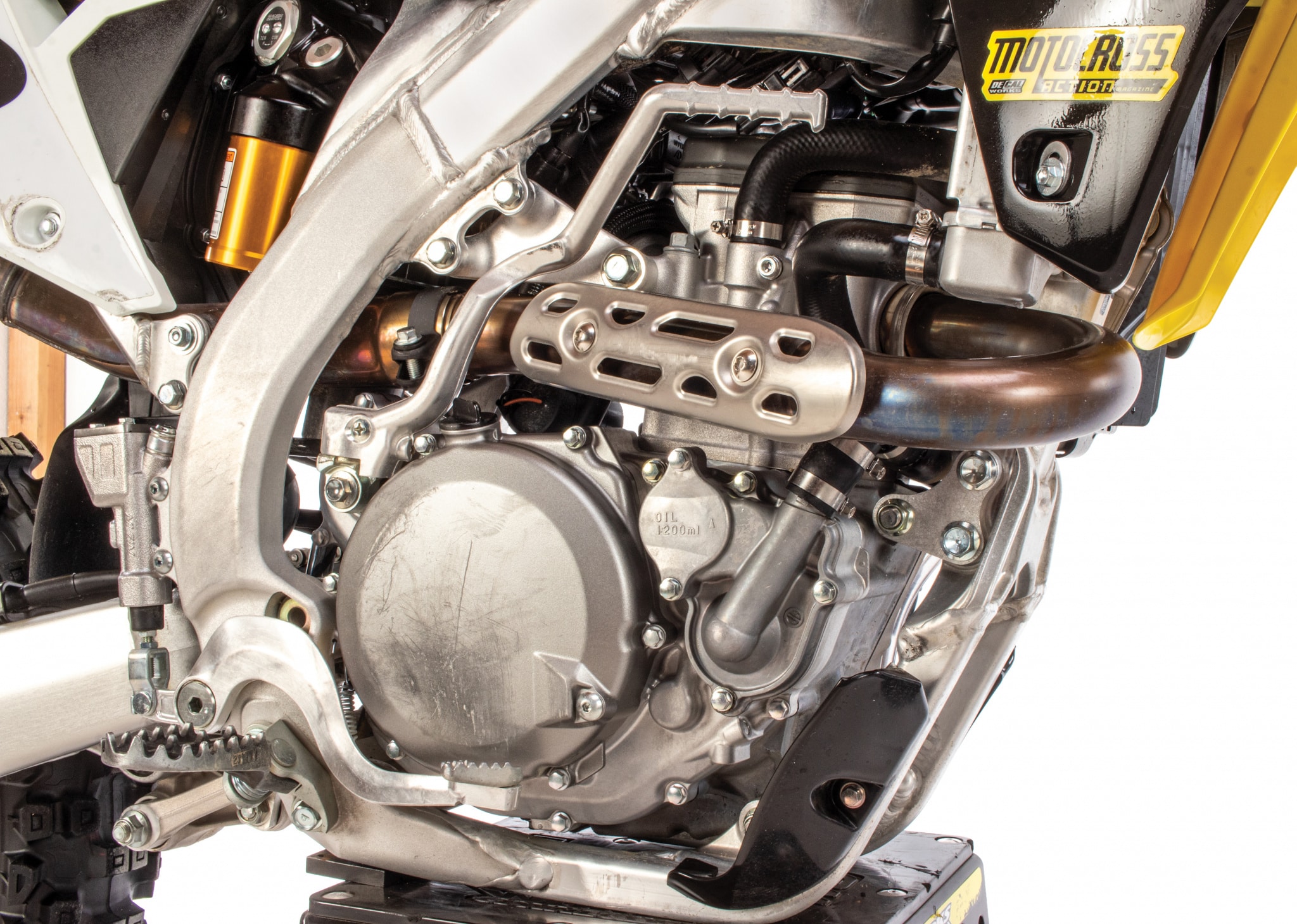 If you have a 2018 Suzuki RM-Z450 sitting in the corner of your garage gathering dust, don’t worry; it is just as competitive as the 2023 Suzuki RM-Z450.
If you have a 2018 Suzuki RM-Z450 sitting in the corner of your garage gathering dust, don’t worry; it is just as competitive as the 2023 Suzuki RM-Z450.
Q: HOW DOES THE 2023 SUZUKI RM-Z450 RUN ON THE TRACK?
A: For the average Novice, Vet or play rider, the existing RM-Z450’s power is located in the perfect spot on the rpm curve to get the job done; however, Pros and high-rpm revvers will not like the RM-Z450 powerband because it gives up too much horsepower on top. You can’t rev the Suzuki RM-Z450 because it doesn’t want to be wrung out. Need proof? At 7000 rpm, the Suzuki is competitive at 45.9 horsepower. At 8000 rpm, the RM-Z makes 52.4 horsepower (while narrowing the gap with the rest of the pack to a reasonable 2-horsepower deficit). The RM-Z450 peaks at 54.39 horsepower at 8800 rpm, which is incredibly low in the powerband when compared to its competition. From 9000 rpm on up, the Suzuki is dead in the water. Need proof? By 11,000 rpm, the 2023 Suzuki RM-Z450 makes 7.5 horsepower less than a Yamaha, KTM, Honda or Husqvarna.
The 2023 RM-Z450 is not a lost cause, nor is it our intention to make the 2023 RM-Z450 engine appear to be a weak sister. When short-shifted, kept in the meat of the powerband and kept off the rev limiter, the RM-Z450 has a very usable, pleasant and effective 450cc powerband. It is brisk off the bottom and strongest from 7000 to 8800 rpm (where the acceleration is generated). There is nothing wrong with a low-to-mid powerband on a 450cc motocross bike, but if you’re looking for top-end power, lots of over-rev and maximum peak horsepower, yellow will not be your color.
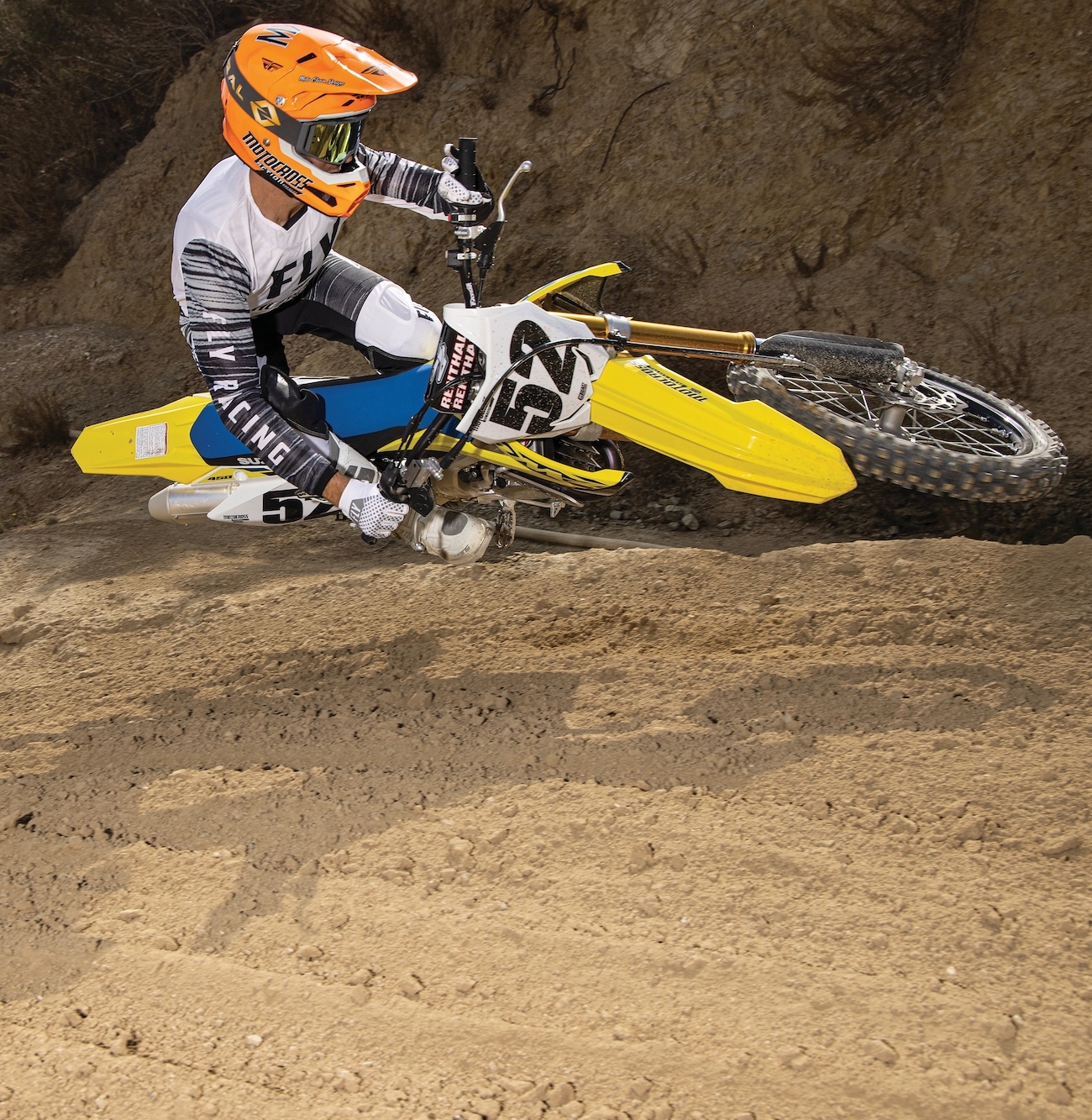
Q: CAN YOU HOP UP THE 2023 SUZUKI RM-Z450 TO RUN WITH THE HIGH-PRICE SPREADS?
A: Yes, you can, but the real-world value of a lower-cost machine is in leaving it alone and racing it as is. If you have to modify it, it won’t be a bargain anymore. Suzuki owners always claim that they could buy a Suzuki and, with the money they saved, make it as good as the Honda or Kawasaki. That is a fantasy. The price difference between a Suzuki and the green and red bike is only $600. That $600 won’t buy an aftermarket exhaust pipe or re-valve a set of Showa forks. Think about this fact: the full-race Twisted Development RM-Z450 engine used on Ken Roczen’s race bike has a price tag close to $10,000.
Here is a breakdown of the mods you can make to your 2023 RM-Z450.
(1) Aftermarket exhaust system. Over the last 10 years, the only RM-Z450 engine updates were adding launch and traction control in 2016. Because of the lack of ingenuity by Suzuki’s engine designers, the aftermarket exhaust pipe manufacturers have been able to fine tune their Suzuki pipes to the Nth degree. Whether it is Pro Circuit, FMF, HGS or Akrapovic, they can all lift the RM-Z450 power out of the doldrums.
(2) Gearing. We switched the stock 13/50 gearing for 13/51 sprockets. This allows us to use third gear sooner and get more drive out of tight turns to make up for the 4-horsepower hole that Suzuki put us in.
(3) High-pressure radiator cap. The stock 1.1 kg/cm2 RM-Z450 radiator cap allowed our RM-Z450’s coolant levels to drop during long motos. Twin Air and CV4 offer 1.8 kg/cm2 and 2.0 kg/cm2 radiator caps.
(4) Heavy-duty clutch springs. Heavier springs improve clutch feel, increase bite on acceleration and increase the stock clutch plate life. We don’t always run all the heavy-duty clutch springs; sometimes we find that three stiff springs can fine-tune the feel at the lever.
(5) Works Connection Elite clutch perch. With the stiffer clutch springs installed, the clutch pull was harder than stock. To cure this, we swapped the stock Suzuki clutch perch for a Works Connection Elite clutch perch assembly. If you have the money, a Hinson or Rekluse clutch is the best fix.
(6) TM Designworks chain guide. The stock RM-Z450 chain guide wears out incredibly fast and will not only eat through the rubber buffer but the metal cage as well. We run a TM Designworks Factory chain guide. It lasts almost indefinitely.
(7) Shock linkage. We ran a longer Pro Circuit shock linkage than the stock 135mm link. The longer link lowered the rear of the Suzuki and stiffened the initial part of the shock stroke, which allowed us to have more options in compression, rebound, fork height and head angle.
(8) Shock. We sent our BFRC shock to Brian Medeiros at Ekolu Suspension. Brian Medeiros is an MXA test rider and raced a Suzuki RM-Z450 in 2021 and an RM-Z250 in 2022 (and qualified at the Washougal and Pala 2 Nationals on a stocker). Ekolu sets up a BFRC shock to be better balanced, squat on corner entry, improve rear-wheel traction and not step out when leaned into a bumpy corner. You can reach Brian at (951) 459-7993.
(9) Balance. The whole chassis is out of balance. MXA’s goal on the 2023 Suzuki RM-Z450 was to get the rear end down and the front end up. This would kick the head angle out to slow down the steering input with the added benefit of not head shaking as much. We slid the forks down into the triple clamps. How far down? Flush would be about right. The longer Pro Circuit link lowered the rear of the Suzuki and stiffened the initial part of the shock stroke, which allowed us to have more options for compression and rebound settings, fork height and head angle.
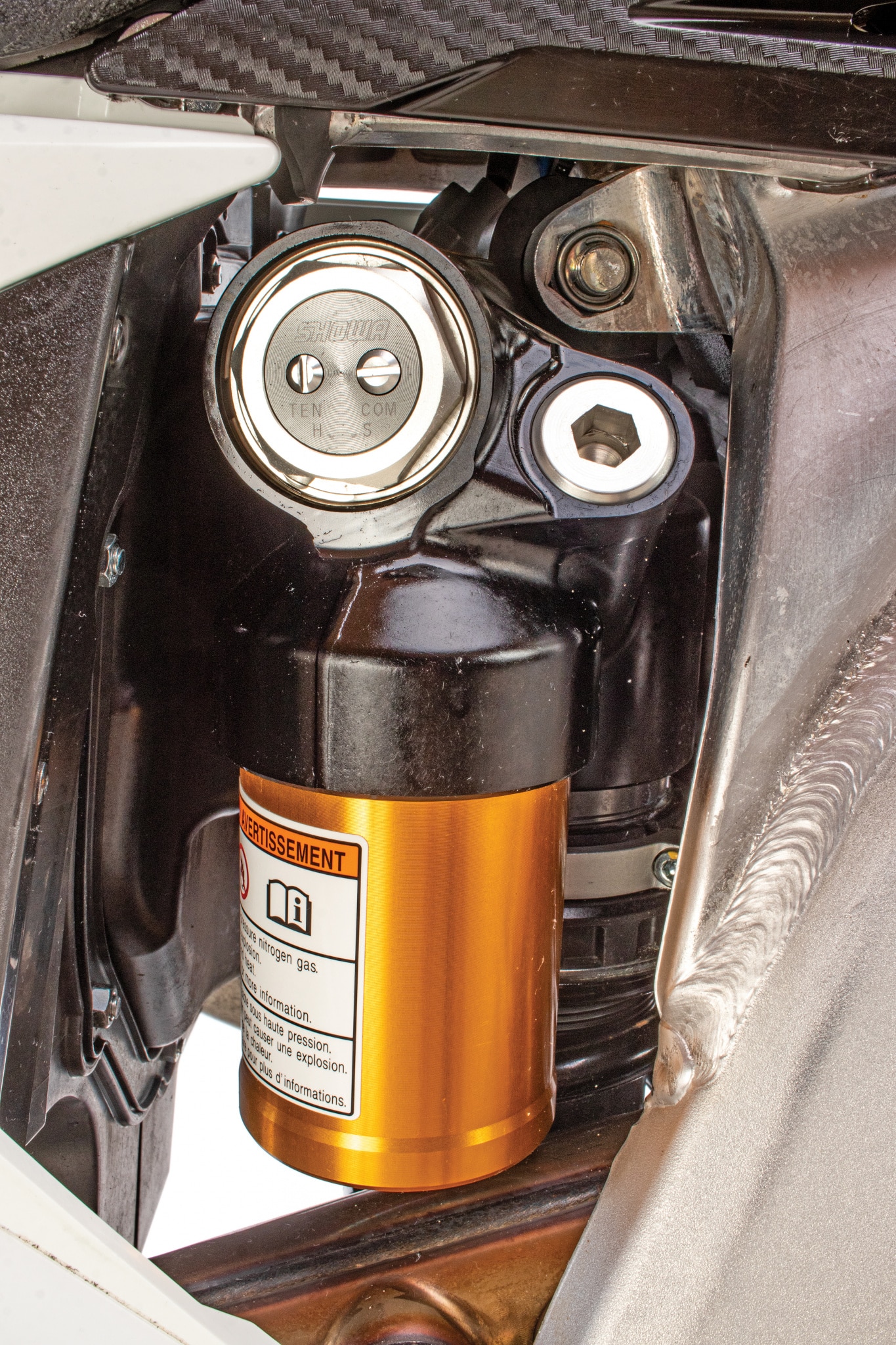 The Showa BFRC shock is a failed science project, and don’t be fooled by works BFRC shocks.
The Showa BFRC shock is a failed science project, and don’t be fooled by works BFRC shocks.
Q: WHAT DID WE HATE?
A: The hate list:
(1) Brakes. Suzuki has a 270mm front rotor but did not put enough effort into the master cylinder/caliper design to help with modulation. It’s powerful but grabby.
(2) Kickstart. The lack of an electric starter isn’t the end of the world for the Suzuki RM-Z450, but it isn’t on the cutting edge of motocross advancement, either.
(3) BNG. In years when a manufacturer doesn’t make any mechanical updates, it would be wise to put more than zero effort into the graphics.
(4) Weight. One bike has to be the heaviest bike on the track, but why is it always the RM-Z450?
Q: WHAT DID WE LIKE?
A: The like list:
(1) Cornering. The RM-Z450 is at its best on the entrance to turns. In its glory days, the Suzuki was the only bike that turned without effort—not so anymore.
(2) Power. The 2023 RM-Z450 has a well-placed powerband. It doesn’t make much in the way of peak horsepower, but the power it makes is very usable.
(3) Traction control. The 2023 RM-Z450 features a traction-control system that continually measures throttle opening, engine speed and gear position to adjust the ignition timing and fuel-injector duration to stop wheelspin.
(4) Holeshot Assist. Suzuki’s Holeshot Assist Control (S-HAC) offers three mapping modes for different starting-line setups. We’d be happy with one launch control button that didn’t require us to read the owner’s manual to operate.
(5) Mapping. The GET-developed MX-Tuner 2.0 app allows you to remap the Suzuki RM-Z450 from your Apple or Android smartphone—once you jump through some hoops.
(6) Bridgestone tires. The Bridgestone Battlecross X30 tires are a change from the almost universal Dunlop MX33.
Q: WHAT DO WE REALLY THINK?
A: No one is deluded into believing that the 2023 Suzuki RM-Z450 is the best bike on the racetrack, but it offers a ridable, raceable and enjoyable bike for someone who wants to get in on the motocross experience without having to file for bankruptcy. As it sits, it is still the best bargain in motocross, but only if you get the suspension dialed in and leave everything else alone.
In a perfect world, the Suzuki engineers need to shave at least 10 pounds, add electric starting, get rid of the weird BFRC shock, design a totally new engine (not just because the current engine is the slowest in the class but because that is where the extra weight is), build a clutch that maximizes power (instead of slip), and find test riders who prioritize balance over partial fixes. Suzuki has the know-how to build a world-beating RM-Z450, but Suzuki has spent the greater part of the last decade watching its competition pull away with new technology while they embraced the old.
MXA’S 2023 SUZUKI RM-Z450 SETUP SPECS
This is how we set up our 2023 Suzuki RM-Z450 for racing. We offer it as a guide to help you get your own bike dialed in.
SHOWA COIL-SPRING FORK SETTINGS
After living through the SFF-TAC air fork years, every racer raves about coil-spring forks, but there isn’t a lot to rave about. Yes, they are better than SFF single-spring forks or the terrible SFF-TAC air forks, but that’s setting the bar pretty low. As with all the late-model Showa coil spring forks, these forks are too soft for anything but lightweight riders. For hard-core racing, these are MXA’s recommended 2023 RM-Z450 fork settings (stock settings are in parentheses):
Spring rate: 0.50 N/mm
Compression: 10 clicks out (6 clicks out)
Rebound: 12 clicks out
Fork-leg height: Adjust it for the handling, not for the suspension.
Notes: We added 10cc of oil to both fork legs to stiffen the forks in the last 4 inches of travel to stop them from bottoming. This gave us more leeway in dialing in the compression. MXA test riders ran the compression from seven to 12 clicks out, depending on rider speed and track conditions.
SHOWA BFRC SHOCK SETTINGS
We wish that the more traditional RM-Z250 rear shock came on the 2023 RM-Z450s. It doesn’t. It should be noted that on the BFRC shock, the compression and rebound are adjusted by counting turns on the bleed screws, not by clicks. The BFRC shock does not have a high-speed compression adjuster. Additionally, there is no rebound adjuster under the shock. Both compression and rebound adjusters are mounted on the piggyback and labeled “Ten” for rebound and “Com” for compression. For hardcore racing, these are MXA’s recommended 2023 Suzuki RM-Z450 shock settings (stock settings are in parentheses).
Spring rate: 54 N/mm
Hi-compression: N/A
Compression: 1 turn out (1.5 turns out)
Rebound: 1 turn out (3 turns out)
Race sag: 105mm (108mm)
Notes: We hated the high-in-the-rear layout of the 2023 RM-Z450. We tried lowering it with massive race sag changes, because we had no other option, but it made the rear end a little harsher (while helping the chassis). We eventually ran a 1mm-longer shock linkage, which lowered the rear of the bike and stiffened the initial shock damping. We recommend the link.
2023 SUZUKI RM-Z450 VIDEO TEST



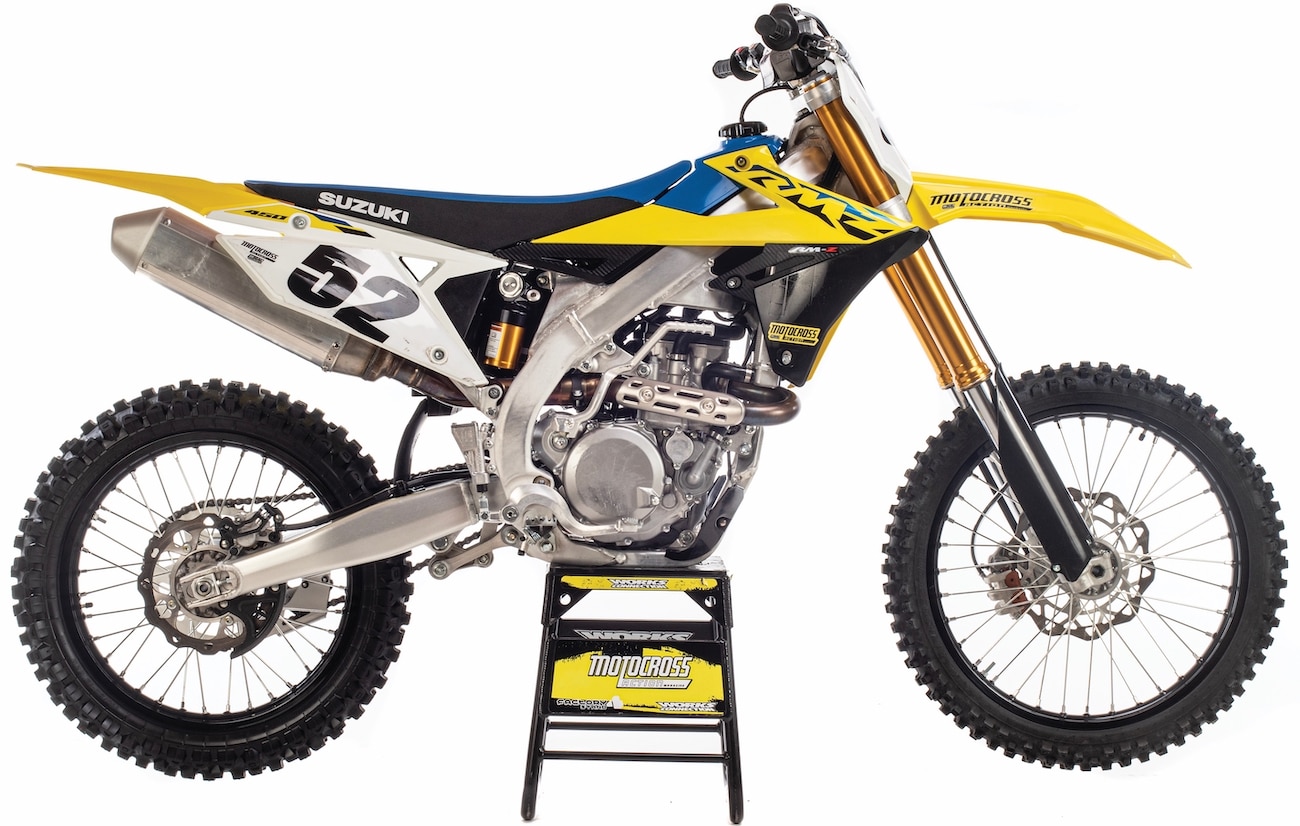




Comments are closed.